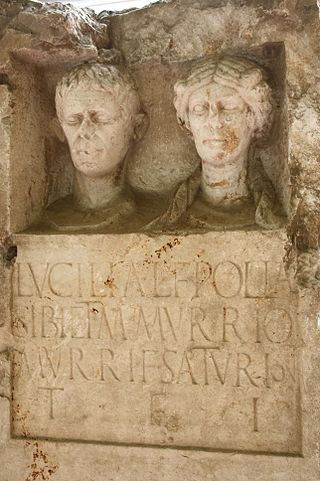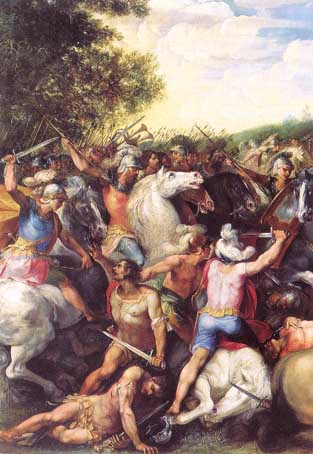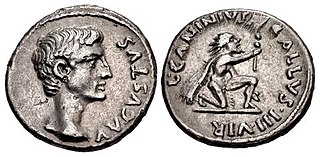
The gens Lucilia was a plebeian family at ancient Rome. The most famous member of this gens was the poet Gaius Lucilius, who flourished during the latter part of the second century BC. Although many Lucilii appear in Roman history, the only one known to have obtained any of the higher offices of the Roman state was Lucilius Longus, consul suffectus in AD 7.
The gens Fulvia, originally Foulvia, was one of the most illustrious plebeian families at ancient Rome. Members of this gens first came to prominence during the middle Republic; the first to attain the consulship was Lucius Fulvius Curvus in 322 BC. From that time, the Fulvii were active in the politics of the Roman state, and gained a reputation for excellent military leaders.
Publius Autronius Paetus was a politician of the late Roman Republic who was involved in the conspiracy of Catiline.
The gens Papiria was a patrician family at ancient Rome. According to tradition, the Papirii had already achieved prominence in the time of the kings, and the first Rex Sacrorum and Pontifex Maximus of the Republic were members of this gens. Lucius Papirius Mugillanus was the first of the Papirii to obtain the consulship in 444 BC. The patrician members of the family regularly occupied the highest offices of the Roman state down to the time of the Punic Wars. Their most famous member was Lucius Papirius Cursor, five times consul between 326 and 313 BC, who earned three triumphs during the Samnite Wars. Most of the Papirii who held office under the later Republic belonged to various plebeian branches of the family. Although the most illustrious Papirii flourished in the time of the Republic, a number of the family continued to hold high office during the first two centuries of the Empire.
Gnaeus Domitius Ahenobarbus was tribune of the people in 104 BC. He was the son of Gnaeus Domitius Ahenobarbus, and brother of Lucius Domitius Ahenobarbus. The College of Pontiffs elected him pontifex maximus in 103.

The gens Caesia was a minor plebeian family at ancient Rome during the late Republic, and through to imperial times. The first member of this gens to achieve prominence was Marcus Caesius, praetor in 75 BC. Under the Empire, the Caesii were distinguished for their literary achievements.
The gens Aelia, occasionally written Ailia, was a plebeian family in Rome, which flourished from the fifth century BC until at least the third century AD, a period of nearly eight hundred years. The archaic spelling Ailia is found on coins, but must not be confused with Allia, which is a distinct gens. The first member of the family to obtain the consulship was Publius Aelius Paetus in 337 BC.
Lucius Manlius Torquatus was a consul of the Roman Republic in 65 BC, elected after the condemnation of Publius Cornelius Sulla and Publius Autronius Paetus.
The gens Autronia was a plebeian family at Rome. Persons of this gens first came into notice in the last century of the Republic; the first member who obtained the consulship was Publius Autronius Paetus, in 65 BC.
The gens Caesennia was an Etruscan family from Tarquinii during the late Roman Republic and in imperial times. Two of its members were mentioned by Cicero, and the name is found in sepulchral inscriptions.

The gens Hostilia was an ancient family at Rome, which traced its origin to the time of Romulus. The most famous member of the gens was Tullus Hostilius, the third King of Rome; however, all of the Hostilii known from the time of the Republic were plebeians. Several of the Hostilii were distinguished during the Punic Wars. The first of the family to obtain the consulship was Aulus Hostilius Mancinus in 170 BC.

The gens Caninia was a plebeian family at ancient Rome during the later Republic. The first member of the gens who obtained any of the curule offices was Gaius Caninius Rebilus, praetor in 171 BC; but the first Caninius who was consul was his namesake, Gaius Caninius Rebilus, in 45 BC.
The gens Sextilia was a plebeian family at ancient Rome. The first member of this gens to achieve prominence was Gaius Sextilius, consular tribune in 379 BC. None of the family obtained the consulship, but they endured throughout Roman history from the early Republic into imperial times.
The gens Cincia was a plebeian family at Rome. The first member of the gens to achieve prominence was Lucius Cincius Alimentus, who was elected praetor in 209 BC.
The gens Cispia was a plebeian family at Rome. Although the gens was supposedly of great antiquity, the Cispii only achieved prominence toward the end of the Republic.
The gens Fadia was a plebeian family at Rome. Members of this gens are first mentioned around the time of Cicero, but they did not obtain any of the higher offices of the Roman state under the Republic. Their fortunes improved under the Empire, and two of the Fadii held consulships during the second century.

The gens Considia was a plebeian family at ancient Rome. The Considii came to prominence in the last century of the Republic, and under the early Empire, but none of them rose any higher than the praetorship.
The gens Cornificia was a plebeian family at Rome. No persons of this name occur until the last century of the Republic; and the first who obtained any of the higher honours of the state was Quintus Cornificius, praetor in 66 BC.
The gens Cossinia was a plebeian family at Rome. The gens originated at Tibur, and came to Rome early in the first century BC. None of its members ever obtained the higher offices of the state.
The gens Tarquitia was a patrician family at ancient Rome. Few members of this gens appear in history, of whom the most illustrious was Lucius Tarquitius Fiaccus, who was magister equitum in 458 BC. Other Tarquitii are mentioned toward the end of the Republic, but were probably plebeians, rather than descendants of the patrician Tarquitii.
![]() This article incorporates text from a publication now in the public domain : Smith, William, ed. (1870). Dictionary of Greek and Roman Biography and Mythology .
This article incorporates text from a publication now in the public domain : Smith, William, ed. (1870). Dictionary of Greek and Roman Biography and Mythology .



